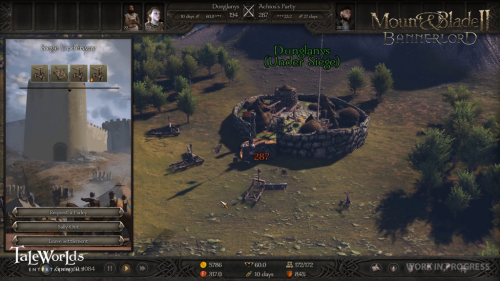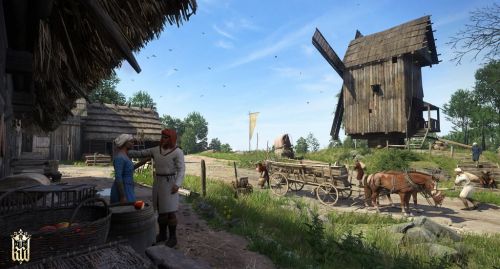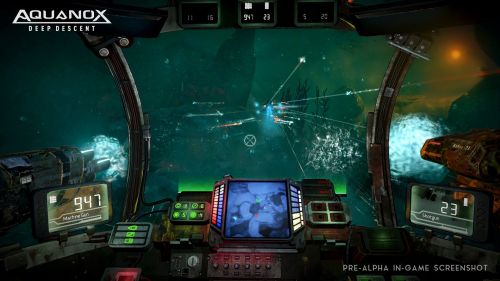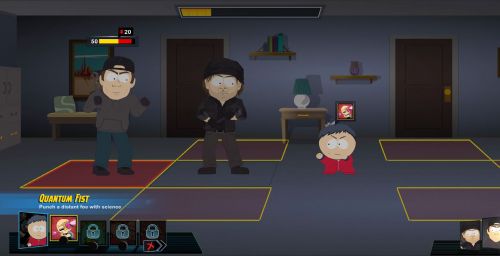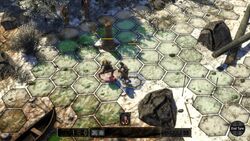RPG Codex Report: Gamescom 2016 - Mount & Blade 2, Kingdom Come, SpellForce 3, South Park 2 and more
RPG Codex Report: Gamescom 2016 - Mount & Blade 2, Kingdom Come, SpellForce 3, South Park 2 and more
Editorial - posted by Infinitron on Fri 2 September 2016, 01:11:55
Tags: Gamescom 2016; Grimlore Games; KING Art Games; Kingdom Come: Deliverance; Morning Men; Mount & Blade II: Bannerlord; Pixel Federation; South Park: The Fractured But Whole; Spellforce 3; TaleWorlds; The Dwarves; Ubisoft; Warhorse StudiosGamescom Codex: Mount and Blade 2, Kingdom Come, Spellforce 3, Morning Men, and South Park: The Fractured But Whole
[by Bubbles]
Last year's Codex Gamescom Report was such a rousing success that I and Jarl felt we had to do it again this year. I booked presentations, hands-ons and interviews for 26 games (almost all of them RPGs), and we took great care to formulate critical and in-depth observations for every single one of them. Our schedule was so deeply prestigious that Jarl even attended for the whole three days this year, wanting to soak up as much gaming knowledge as he could. Eager to one-up him, I extended my stay in Cologne by an extra day and attended GDC Europe, where I conducted a 150 minute interview with Codex darling Josh Sawyer to talk about his critically acclaimed hit RPG “Pillars of Eternity”.
In other words: we have a whole lot of content for you, and we're eager to get it all published before Christmas. Last week, we devoted a whole article to the potentially good RPG Divinity: Original Sin 2; from this week onward, we'll be bundling multiple games into a single report again. Let's begin.
Mount & Blade 2: Bannerlord
[by JarlFrank; image captions by Bubbles]
While Bubbles was busy interrogating Swen about Original Sin 2, I went to see the presentation on Mount and Blade 2 that we had booked. It was a pretty large booth, with more space inside than most of the others we visited on our Gamescom trip, and I shared the room with a couple of other journalists of less prestigious magazines than the Codex.
The presenter greeted us, saying he was an animator and that his name is - at least that's what it sounds like on the recording I made - Stan. He didn't look like a Stan, so I probably just misheard it due to the crappy quality of the audio. He asked the audience whether they knew what kind of game Mount and Blade was, and despite being gaming journalists, the audience made affirmative sounds, proving to be unusually well-informed for the gaming press.
"Our games are pretty unique," he said, "and this time we're trying to tie it more together so we can deliver a deeper and more sensible game that is easier to understand for the player, and offers him more options." There's going to be a big focus on improving the AI compared to the previous games, he says, and we're going to witness a defensive siege battle to showcase how much sieges have been improved over the dull affair they were in the previous M&B games.
The presentation started on the overland map, with the player having an army of 200 men, but there's an enemy army with even larger numbers nearby, and so the player retreats into his nearby town and fortifies his position there. All this is, by the way, not actual live gameplay: it's a pre-recorded gameplay video played on a big TV screen, and by now this exact footage should be uploaded on YouTube for all to see. "This is the town we collect our taxes from," possibly-Stan says. "It collects its income from the nearby villages, and we have a full feudal system here where every town, village and character has their own incentive to thrive and grow prosperous."
Then the enemy lays siege to the town, and we're shown the different options you have during a siege. It is possible to construct siege weapons, both as an attacker and as a defender, you can sally out to harass the enemy and damage the siege weapons they have built in order to delay their assault, or you can attempt to parley with the besiegers, offering them money or even surrendering the castle without a fight in exchange for peace with your kingdom.

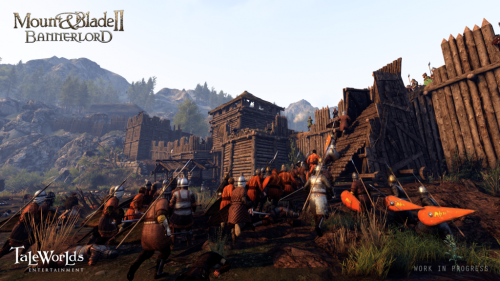
With its enthusiasm for life, the colour orange relates to adventure and risk-taking, inspiring physical confidence, competition and independence. Those inspired by orange are always on the go!
Depending on the circumstances, a diplomatic deal like that could either gain you or lose you reputation with your faction. If you're losing the war, your king will be grateful for having made a peace deal, if you're winning the war, he'll be furious at you for giving the enemy your castle without a fight and ending the war which had been going so well up to this point. The diplomacy menu reminds me of strategy games such as Civilization and Total War, where both sides can make different offers such as gold and territory, and it is heavily inspired by the Diplomacy Mod for Warband, as probably-Stan later admits.
The first thing the player does in the gameplay presentation is a sally. He charges the enemy camp with a couple of cavalrymen, attempting to destroy the ram that is under construction there. The fight doesn't go all too well - while the ram gets destroyed, the player's casualties are higher than the enemies, and he pulls his troops back before they are overwhelmed. "In a sally, the enemy doesn't have his whole army spawned from the beginning," explains maybe-Stan. "At first you have the element of surprise, but the longer the battle lasts, the more enemy troops will come to the battlefield and you should pull out before they overwhelm you. We lost about 34 men and the enemy lost 27 so this wasn't super successful, but we bought some time by destroying their ram."
A sally might be a good idea if you know an allied army is nearby and will reach your town soon, and you want to buy time by delaying the assault. That didn't happen in the presentation, however, and once the besiegers have rebuilt their ram, the assault begins. "From the start of the battle, you can read what is going to happen by studying the enemy positions," we are told. When a siege tower is on the left side, it is going to attack the left side of the wall. If there are ladders on the right side, they're going to be raised there."We took a lot of inspiration from real sieges and we want it to work as it did in history, from about the 9th to the 11th century, which is our main inspiration. There was no such thing as placing a siege tower on the right flank and then carrying it to the other end of the battlefield, there was always a plan behind the initial positioning, and therefore it is also easy for the defender to read that plan."
The first thing the player can do is to position his own siege equipment - defensive ballistae and catapults that can fire powerful projectiles at the assaulting enemy. The placement of these should follow several tactical considerations: the siege tower might be large and allow many enemy soldiers to storm your walls at once, but it is the slowest of all siege weapons, and the ladders are going to be raised first and are more vulnerable than the tower. You know where the enemy has placed his siege equipment, and you can place yours accordingly, depending on what you want to achieve.
"There is partial destruction on the towns, and on the siege weapons too," we're told. A direct hit with a catapult can severely damage or even destroy the enemy's siege tower, but the same can happen to our wall-mounted siege weapons if they're hit, and catapults can break small holes into the walls, destroying the crenellations and exposing the defenders to arrow fire from below.
Once the battle starts, the player goes up to the battlements and shoots a couple of arrows at the incoming enemies. At one point, he also takes over a ballista to operate it himself - every siege weapon can be manned and controlled by the player if he so wishes - and when the enemies broke through the outer gate, charge into the gatehouse and attempt to break the inner gate, the player positions himself next to a pile of rocks which he can throw on their heads through a murderhole.
The battle ends in a huge clusterfuck at the gates, with masses of soldiers in tight formations bashing at each other until one side gives in. It is the enemy that finally routs, and the battle is won. "They routed because their commander was killed in battle," said maybe-Stan. "This is new in Bannerlord, in Warband it was less permanent, characters could only be captured and weren't deleted from the world. But now they can actually die, and this guy's king will have to find other characters to grant his now lordless fiefs to."
And with that, the pre-Stan-ter thanked us for our attention and concluded the presentation.
Of course, I had a few questions about some of the features he'd shown, and now was the right time to ask them.
Jarl: So, that little bit at the end... does that really mean every character can die permanently now?
Probably Stan: Yes, every character can die in battle.
Jarl: That's a great improvement, makes the world less static. Speaking of the world, what measures are you taking to make it more interesting? Are you adding new features to make the management of your castle more involving, for example?
Possibly Stan: You can strengthen the walls, and of course you can do everything that you could in Warband, uhm... we're not talking too much about the management of the cities and the castles, but it works a little bit differently. Like I said, we have a fully working economic system right now with the villages producing something and taking that to the nearby towns and selling it, so for example if you were to, er, like, you own this village, right? And they're producing cow milk and meat, and then there's bandits coming in and destroying their farms, then they're not being able to pay their taxes, and the lord who owns this village will then suffer economically, and you can do this to other lords as well, you can target their riches, their purse, and make them hate you. It opens up a lot of possibilities when it comes to interaction with the characters and the world.
Jarl: So you also have more possibilities to hurt your enemy, you have more possibilities to permanently do damage to them by razing a village or by killing a character?
Stan, I guess: Yeah, and whether you want to take part in this world or not, if you spend time in it you will realize that the sandbox is evolving and moving and changing, if you partake in it or not. And you can also choose to be a cruel or a fair lord, you choose how much tax you want from your villagers, if you push them too hard they might rebel. Just like in Warband we had that picture in the background with peasants saying our lord is taking too much taxes from us, now you can actually be that lord yourself.
Jarl: Final question: in Warband it was always difficult to raise armies of the same size as AI lords. Has this changed? What's the maximum army size in Bannerlord?
Stan: All right, so standard is a little more than in Warband, we've done tests on machines in our own office, up to a thousand troops in a scene, and there was no issues with it, but we haven't really focused on making more soldiers as a main thing, we're striking more for quality rather than quantity. But yeah, definitely more than in Warband.
I had no further questions, and the interview part of the Mount and Blade 2 presentation concluded. Since the other guys in the room were real gaming journalists, they didn't have any questions of their own (of course). We got handed our press kits and t-shirts and sent on our merry way.
Then, I went back to Divinity: OS2 for a couple of minutes, which is the point of the interview between "Jarl re-joins us" and "Jarl leaves for Kingdom Come", which I used to ask a few questions to Swen.
---
Mount and Blade is one of these games that I really tried to like, and which I played a lot, but it never really clicked with me. The main issue I had with it was the boring and repetitive lategame due to the untactical clusterfuck that were the sieges, and the relatively static world didn't help much in that regard, either. Lord were always merely captured and could never die, when you assaulted a castle there was only one pre-determined access point. I always abandoned my games about halfway through because from some point onward, it just wasn't that much fun.
This is why the Bannerlord presentation was such a pleasant surprise to me. The sieges are no longer boring, static affairs with pre-determined access points on the walls, instead they're dynamic and feature all kinds of siege weapons, such as catapults, rams and siege towers. Both the attacker and the defender have many more options now, and there are some actual tactics involved. I really, really liked what I saw there. Sieges are finally going to be fun, which fixes my main point of frustration with the previous games.
The changes in the world's economic model and the fact that NPCs can now actually die is another huge step in the right direction. Villages grow now, and a wooden castle might turn into a strong fortress of stone through the course of the game, depending on the wealth of the region. Characters can die in battle, so theoretically you could start the game in the southernmost kingdom of the world, form some relationships with local lords, then go north for a change, spend a long time up there, return down south - and find a completely different political landscape because everyone you knew is dead.
I really liked what I've seen there, and the answers to my questions just confirmed it: Mount and Blade 2 is going to fix the worst aspects of the previous games, and it's going to be a huge step forward for the series.
Kingdom Come: Deliverance
[by JarlFrank; image captions by Bubbles]
Compared to last year's Gamescom, Warhorse's presence was much less significant. They had only one room compared to last year's three, which was a darkened presentation room with a TV screen on the front wall and a suit of plate armor in the corner; the hands-on room and the lounge where I interviewed Vavra last year were missing, and this time Dan wasn't even there personally. On the other hand, this year's presentation showed how much progress the game has made since then, and the reduced presence was likely due to the company focusing on finishing the game instead.
Where last year, I still asked Vavra how he's going to fill the game with content, as a historically correct game will lack genre staples such as dungeons and magic equipment, this year I left the presentation room with a much clearer picture of what the gameplay is going to be like. And that which we were shown looked pretty damn good. It was, overall, one of the most impressive presentations at Gamescom - mostly because it was an actual live gameplay presentation rather than just a pre-recorded video, and the outcome of actions wasn't always certain.
The gameplay we were shown was an infiltration quest into an enemy camp. Your liege ordered you to spy on and, if possible, sabotage a Hungarian/Cuman war camp, and how you do this is entirely up to you. "You could even convince your lord to attack right away if you don't feel like doing this quest," we are told. "Of course, that will make the fight harder as you won't know the layout of the place, and the entire garrison will be able to run to the defense, but if you want to take that risk, we let you."
If you don't tell your liege lord to attack right away, you have a couple of different approaches in how to sabotage the place. Sneaking inside and poisoning the food is one option, killing the patrols on the roads is another. And there are multiple ways to go about these tasks, too. In this presentation, we were shown two approaches - the direct approach and the stealthy approach. One of them was successful, the other ended in death. I think you can guess which was the lethal one.
"When you have a dagger, you can do stealthkills from behind," the presenter says. "You can't parry with a dagger, and it's a pretty useless weapon in combat, but it allows you to take out your enemies without a fight if you manage to sneak up on them. If you don't have a dagger, you can choke out an enemy until he's unconscious, but beware: he's going to wake up and alert his mates after a couple of minutes!"
That mechanic can work to our advantage, too. We're not shown this in the presentation, but we're told that this can create an effective distraction: you could choke out a patrolman, wait until he wakes up and runs to the camp where he'll report the incident to his comrades, and they'll come out to the place where you hit him and search the area. This will leave the camp with half as many guards as usual, and you can sneak in through a backdoor and stroll through a mostly empty camp, sabotaging the place to your heart's content.
After the patrolman got choked out, the player walks towards the front gate, which is an incredibly stupid move (and only done to show us how incredibly stupid it actually is). The player is clad in dark clothes - armor is noisy as fuck and will make sneaking almost impossible, but not wearing armor will make you very vulnerable in straight-up combat - and the gate guards tell him to piss off because he obviously has no business there. The player approaches anyways, and the guards rush up to him with weapons drawn. Unarmored and outnumbered, it doesn't take him long to be sliced to bits. "The frontal assault is obviously not a good idea," the presenter says with a smirk and a wink, "so this time, we're going to try something different."

If you think this looks cool, watch some combat footage from the alpha. You'll change your mind quickly.
The game is reloaded, and this time the player stabs the patrolman, hides the body, picks up his halberd and follows a second patrolman - this one is mounted, and the player uses the halberd to show how effective polearms are at unhorsing mounted troops. With the halberd, the player pushes the guy from his horse and he falls to the ground; the whole thing is really nicely animated, and it's great to see polearms receiving some well-deserved love in this game. They are powerful weapons that grant you the advantage of reach, and even though the patrolman manages to get to his feet, he doesn't stand a chance against us with his sword.
"In tight quarters, your attacks with a polearm will be severely limited, of course. When there's a wall right next to you, you won't be able to swing it and will be restricted to stabs. We're trying to give each class of weapon its own advantages and disadvantages, and in some situations you might prefer one type of weapon over the other. They don't just have different stats, they actually have different uses."
Then, the body is stipped and the player puts on the patrolman's armor: a full set of Cuman armor, including helmet, which will make for a great disguise if we try to infiltrate the camp. "We should also take care to hide the body, because the guys in the camp will realize at some point that their patrolmen are missing," says the presenter. "If there are ten patrolmen around a camp, and you kill every single one of them without being detected, after a while they'll send out some men to look for the missing patrols. Our AI doesn't only notice dead bodies, they also notice when a post that should have a soldier positioned there is empty."
With the freshly looted Cuman armor on, the player approaches the gate and nobody pays him any attention, at least initially. "Sometimes, one of the gate guards will approach you and ask you a question. We've had presentations where this didn't happen, but I hope it happens now because we can show the dialogue skills if he does."
We're lucky and one of the guards approaches us, asking a question in Hungarian. Obviously, he thinks we're one of his comrades, because we're clad from head to toe in Cuman armor. "Your character is Czech, and his native language is Czech. He's not fluent in Hungarian, so if you say the wrong thing now, you might compromise your disguise. As you can see, there are four dialogue options here, and three of them have a symbol next to them: the symbol represents the governing dialogue skill, and a red, yellow or green bar around it represents the chance of success."
The first dialogue choice lets you answer in Czech, which doesn't have a dialogue skill associated with it at all. Because, obviously, that is the stupid choice that will blow your cover immediately. The next is a speech check that lets your character attempt to answer in Hungarian; it's green because the character's speech skill is quite high and the gate guard isn't very suspicious of you. The next option is "growl at him", which is governed by the intimidation skill (and which has a low chance of success), while the last option is to just ignore the guy, which has an even lower chance of success.
The player answers in Hungarian and manages to form a coherent enough sentence to satisfy the gate guard. Now, he's free to explore the camp without any suspicion. The player walks around the camp for a bit, and then decides to put some poison into a pot of goulash ("It's goulash," says the presenter, "because they're Hungarians, so of course there's a pot of goulash in the camp!"), then goes outside again and advances time.
Advancing time takes quite a long time in this game. Each hour took between 5 and 10 seconds to pass. "We're still trying to optimize it," we're told, "but there's a reason it's that slow. The game doesn't just skip forward for an hour, it actually simulates NPC schedules. Some of the men in the camp might decide to eat, while others might just sit down and relax, while others might stand guard. Their actions aren't scripted, and we can't even be sure that anyone is going to eat from the pot we've poisoned in the three hours we're waiting now."
When the waiting is over, the player goes back into the camp and looks for any poisoned NPCs. The search takes longer than expected, but then we see a guy sitting on a chair, obviously uncomfortable. "Ah, here we go one!" the presenter says triumphantly. "You see, poisoning isn't instantaneous. This guy ate from the goulash and got the poison into his system. We don't know when he ate it, it could've been three hours ago, it could've been half an hour ago. But he's still in the first stage of poisoning: he sits down and is nauseous, and after a while he will go to bed and try to sleep off his nausea. During the sleep, he will constantly lose stamina, and after an hour or two, he will die. It will take the others a while to realize he's dead, and then they're going to check the food - because people don't just die in their sleep for no reason, and they'll try to find out why. So if you poison all the food in the camp, you can take out a handful of enemies, but you will never know how many you'll manage to get as it depends on what the NPCs decide to do. If ten guys eat goulash, those ten will die. If one guy eats goulash and nobody else touches the pot for two hours, and they discover that someone has died from food poisoning, that one guy is all you will get."
Then, the player moves on, looking for another poisoned guy, maybe one in a later stage of poisoning. "Ah, there - yeah, go into that camp, look inside, there's someone sleeping," the presenter tells the player, "I think he could be poisoned, too, it's the middle of the day and I doubt he's sleeping because he's tired. If he's poisoned, he will die soon and then his comrades will notice and then we better get out of there because we might be asked questions when their suspicion level rises. Oh, by the way, if we have a dagger we can also silently kill sleeping characters, but I'm quite certain we'd be spotted, as we're in a busy camp at daytime right now, so we won't try that."
Instead, the player explores the camp some more and demonstrates another way of sabotage: there are baskets with arrows in them, which serve as ammunition for the camp's archers. You can light them on fire, and that way you can reduce the enemy's available ammo. "They don't have infinite ammunition. They have as many arrows as they have in the camp, and if you burn them all, they won't be able to shoot in the coming battle. Of course, we'll only be able to burn one basket because once it's set ablaze, it will attract everyone's attention."
And this is what the player does: he lights the basket up, reducing the enemy's ammunition by about twenty or thirty, and sprints away. The player obviously knows the layout of the camp and heads to a small hole in the palisades, at the back of the camp, where he slips out unseen, avoiding the guards at the main entrance.
"This is just one way to handle this quest, and I hope we managed to show you how dynamic our game is," the presenter tells us. "When you play this, you could just poison the food and then head back to your liege and start the battle, or you could only burn the ammunition, or you can do both like we just did or you can do neither and just scout out the camp without sabotaging it. It's all up to you. The more you do here, the easier the battle will be later. Every destroyed arrow won't be able to be fired by the archers, every sick or dead guard won't be able to defend the camp."
And thus ends the presentation of Kingdom Come: Deliverance, and it was one of the most impressive presentations at this year's Gamescom. It has come so far from last year's early build, so much more content and gameplay was implemented, and the multiple approaches to the quest we were shown looked really great.
Last year, only the sword combat was implemented. Now, they also have polearms and daggers, and in the enemy camp we've seen a couple of guys doing some unarmed sparring with each other. Unarmed combat is non-lethal, and we were told that you can challenge most NPCs to a friendly duel if you want to.
I really like the disguise mechanic, and the stealth gameplay looked pretty damn good. Coupled with an AI that is aware of changes - such as shunning the food if they discover one of their comrades dead from poison, or sending out some men to look for the missing patrol if you kock out or kill them all - this looks to be a game where dicking around and trying out different approaches is going to be a lot of fun.
I'm really looking forward to the game and hope that most quests will be designed as openly as this one. And, as everyone who remembers Bethesda's pre-release Radiant AI videos knows, gameplay presentations like this can be treacherous. I really hope that all of this was as real and unscripted as we were made to believe. I'm willing to give Warhorse Studios the benefit of the doubt there. The presenter gave the impression that sometimes, he really didn't know what was going to happen, and the player was very cautious in his actions, especially when there was a danger of being detected - and they reloaded the game once, and NPC reactions were different each time.
This made this such an interesting presentation: they actually showed some live gameplay rather than a pre-recorded video, and this showed the dynamic elements of the gameplay, such as AI reactions, much more effectively than a pre-recorded video would've done.
If everything we were shown during this presentation makes it into the game, we'll have a real gem on our hands. Explorefags are going to love this shit.
Spellforce 3
[by Bubbles]
Community member Hobgoblin42 gave us an extensive presentation on this game last year, and to be honest, we should probably have left it at that.What I saw of Spellforce 3 this year can be charitably described as a bland RPG/RTS hybrid with no discernible features of interest. I had the opportunity to play the game hands-on in the public area (there was no queue), but I was barely able to play it for three minutes before getting bored out of my mind. I controlled two heroes who were strutting through Generic Fantasy Forest #4325, fighting bandits and monsters (goblins? orcs?) in a dreadful Real Time Without Pause system. My characters had one active ability each -- a whirlwind attack and a heal --, and I simply hit each of these buttons whenever they came off cooldown. The rest of my time was wasted watching my characters sloooowly chip away at the enemy health bars with their auto-attacks. Maybe this kind of combat will seem enormously appealing to Spellforce fans, but personally, I found it far too simplistic to derive any enjoyment from it.
Separate from the hands-on we also attended an English-language presentation on the game by two non-goblinoid developers from Grimlore Games. These new presenters reiterated some of the same promises we had heard before: the game would be extremely faithful to the lore of Spellforce 1 and 2 (whee!), all found equipment "should" be rare and meaningful in its effects, and there would still be plenty of different classes to choose from at character creation. Well, actually the "plenty of different classes" have now been stripped down to two: Warrior and Mage. However, each class will have access to three (!) unique talent trees, and you can dip into multiple trees at the same time, which obviously gives you lots of super cool build options. The whole "D&D-style" character progression system with “up to eight character classes” we heard about last year, with multiclassing and so forth, seems to have been chucked out completely.
Unfortunately, we didn't get to hear many details about the "strategy" / base building half of the game. The presenters told us that we could build a stone mine on a stone deposit (!), and that our workers would automatically take care of most of the micro-management (great!), but the substance of this game mode – if there is any – remained elusive.
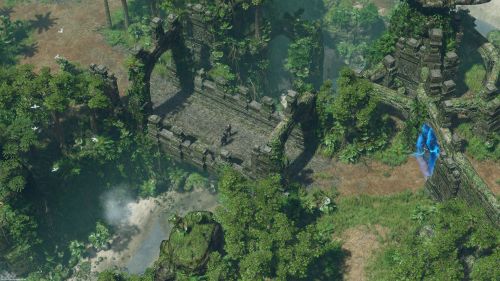

Open up these screenshots and put your ear to the screen. Can you hear the game whispering: "Play me! Play me! I'm really fun"? Yeah, me neither.
Around this point, I began to sense that the scope of the game might have changed a bit since last year. I started asking them directly about the features that had been announced before.
Bubbles: The last time we were here, we heard about a stronghold mechanic. Is that still in the game?
Dev: No. We have…really, the focus is...we have this one giant pillar of bringing these immersive RPG aspects, like character progression, abilities and items, together and merge them with the base building. You can see the dialogue window, and it isn't pausing the game. You really focus on that, that you never pause the game when we have a dialogue, and that will be the main source of the whole experience that brings it together.
Bubbles: So the stronghold is gone, basically?
Dev: Err… in the campaign there will be a hub level.
Bubbles: Like a village? Or a city?
Dev: Yes, something like that, and you can improve that... ...you'll find the master smith, and he will join you, and he will say "okay, I will make much better swords for your human army." And the human army is permanently improved from that point onward.
Bubbles: Are there still dungeon levels with lockpicking, disarming traps, and so forth?
Dev: ...no... ...there are dungeons in the game, but... there will be... ah... locked chests, and there will be a lockpicking ability, but it will be rather simple. If the lock is a certain level, and if your hero has a lockpicking ability, he can open it.
Bubbles: There was talk of a "battle.net"-like multiplayer mode...
Dev: About the technical aspects I can't say so much now, but the game will be playable in co-op mode, so you can play it with one other player, and you can play of course a skirmish mode, which will probably of course have match making and all that kind of stuff. Probably that was meant with these “battle.net.”
Bubbles: There was talk that the story would have political intrigue and some complex stuff in it.
Dev: We have political intrigue, but it is still a high fantasy story. It's true to the lore of Spellforce. You'll get all the elements you know and hopefully loved from the older Spellforce games in the game.
Bubbles: There are a lot of RPG/Strategy clones crowding the market. How would you say your game distinguishes itself?
Dev: We don't see ourselves as an RPG with RTS elements, or an RTS with RPG elements. It is really the most important pillar that you get this constant, unique, evolving experience. You can queue buildings without having all the resources gathered; the workers will come and take care of that, so you can continue exploring with your heroes. Maybe you have a dialogue. During that dialogue, you are attacked by an enemy faction. You cancel out that dialogue, you fight back the attackers, and then you just continue with the dialogue.
[the other presenter chimes in] You can actually close the dialogue window with spacebar, and you can still hear the dialogue going while you go to the other side of the map. Every design decision we make is to create a blend...
Bubbles: Right. The combat was inspired by "old-school" games, and it was meant to be tactical. Is that still the case?
Dev: Yes. The abilties play a big role, status effects play a big role, and there's armour in play. And it might be that you need to create a certain type of army or find a certain type of item to defeat certain enemies.
If we want to have this one big dragon fight, with that mega epic feeling, we say "you can't beat him alone", so you need your army. And there's a big metal golem in the game, and you can't cut him or piece him with weapons; so he's completely immune to those types of damages. But a warhammer is, in fact, very effective against these types of enemies.
And your abilities can also combo with each other. Aimed Shot, for example, if you unlock it, makes irresistible damage, but if you invest a second point it also gains a bleeding status effect. And now that the enemy is bleeding, your other warrior can build up on that by using the Leech ability, which gives you life energy when you use it on a bleeding enemy. So you really need to think about your party composition and combine classes smartly. That's the tactical approach we have to the combat.
Or in multiplayer, if your enemy is just massing archers, then you can give your hero armour that is especially effective against arrows, or make units that are effective against that.
[another attendee asks how the co-op mode works]
We don't have any details yet of the co-op mode; that is something we are still figuring out at the moment. But we really want to evoke the feeling you had on LAN parties earlier, where you'd gather some friends and have fun.
[at this point the next group barges in, and we need to leave mid-conversation]
---
Last year, Spellforce 3 seemed like a relatively ambitious game burdened with an unfortunately dull high fantasy setting; this year, it felt like a waste of my precious Gamescom time. It's natural for a developer to scale down their ambitions during development, but they should take care that the remaining design elements can still create an interesting and appealing game concept. As far as I'm concerned, this is no longer the case with Spellforce 3. But maybe JarlFrank liked it?
Jarl's impressions
Well, I have to agree with Bubbles on this one: Spellforce 3 was one of the least interesting games I've seen at this year's Gamescom, mostly because it was utterly generic, there was nothing particularly special about it, and the presenters didn't seem very passionate, either (quite in contrast to some of the other guys we interviewed). It seemed like not even they really knew what they wanted to do with this game, as it's just a bit of RTS mixed with a bit of RPG and neither element is really the focus and the worst case scenario is we end up with a game that does both things half-assed and isn't very exciting to play, while the best case scenario is a competent Warcraft 3 clone without anything to really set it apart from the competition.
It has a bit of this, it has a bit of that, its mechanics seem to be solid overall, but that's about it. It'll probably end up being good for what it is.
Morning Men
[by Bubbles]
Morning Men was the very first game I saw at Gamescom; Jarl was still stuck in traffic, so I covered it on my own. The game is billed as an episodic, story driven Adventure/jRPG hybrid with "complex branching narratives”; the story is about a young lady named Luditte [sic!] who struggles against some sort of oppressive high-tech society while trying to overcome her own daddy issues. You can watch the trailer on the game's Greenlight page: http://steamcommunity.com/sharedfiles/filedetails/?id=746461247. I asked the developers whether the voice actress was a placeholder; no, she isn't.
I got almost a full 30 minutes of hands-on time with the game, and the devs from the Slovakian studio Pixel Federation even sent me a link to download the demo afterwards; clearly the developers feel that they have nothing to hide. Unfortunately, the game left me unimpressed. It has a distinctive 2D art style and features a lot of reasonably interesting multiple-choice dialogues, but the actual branching was nowhere to be seen. My demo crashed right before the end, and I had to start over from the beginning, allowing me to make a different choice for every single situation and observe the changes; sadly, these changes were minimal. Every different choice loops back to the main plot very quickly, and the demo didn't offer even a single alternate scene. The developers might be able to offer more meaningful choices in the main game, but the game's episodic format makes me sceptical about the amount of branching we could conceivably see here. Mind you, I'm not a fan of Telltale games either; if that kind of “narrative adventure” floats your boat, you might be more receptive to Morning Men than I was.
Apart from the story, there's no much else to the game. One of the developers estimated the gameplay to consist of “65% story, with the rest spent on inventory management and combat.” He didn't even mention puzzles. The inventory chiefly exists to feed into the combat; you don't spend your time on complex item combinations, but instead on swapping out your gun and getting a better piece of armour. These items can then be used in a relatively simplistic type of RPG combat that seems distinctly less complex than it was in the hybrid games of yore (see Superhero League of Hoboken for a fine representative of the genre). Basically, you get a side view of a battlefield, with your party on the left and the enemy on the right; you can select an enemy, choose an ability (the demo only offered “shoot”), then you shoot, then your companions and the enemies act according to their AI, and then you can shoot again. And that's it. Winning a battle will reward you with experience, but it's not clear what the character progression system will look like.
Apart from the combat, all the movement and interactions in the demo were handled through dialogue windows; there was no point-and-click gameplay of any sort. In a way, the game reminded me less of an Adventure/RPG hybrid and more of a visual novel with an inventory and some combat grafted on top.
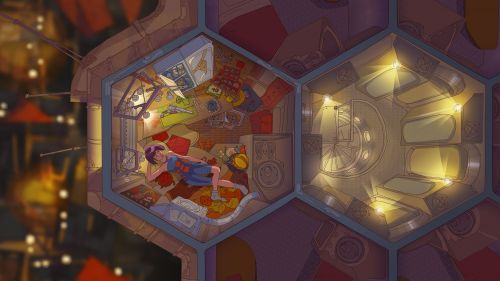
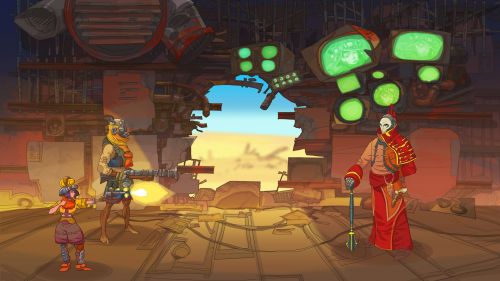
The screenshots in the press kit don't show any gameplay and don't include the UI, so they're basically just pretty pictures. The pic on the right shows the battle screen.
The developers mentioned that they wanted to implement lots of cool combat abilities into the game, but I'm not sure if these ambitions will ever come to fruition. The devs are not even certain how long the story of this “season” is going to be; one developer mentioned that he'd like to do 5 episodes, and that he “already [has] ideas for episodes 2 and 3.” He added that the game had originally been envisioned as a “Dark Souls-like 3D co-op game”; and no, he wasn't winking or giggling when he said that. The current version of the game had only emerged after a “long process”, during which they had decided that the story was really the most important thing about their design after all. I encourage you to read between the lines.
Still, if you now feel the irresistible urge to give Morning Men a go, you should be able to play the first episode on Steam on November 22 of this year. The developers estimate a “two to six hour” duration and the art style really is quite nice.
The Dwarves
[by Bubbles]
“Sorry, but your slot accidentally got triple-booked. We urgently need to leave to talk to Gamestar right now, but maybe we can reschedule?” This on Friday afternoon, five hours before the trade area closed down for good. No, we couldn't reschedule.
In general, the THQ Nordic + EuroVideo booth was a mess this year; their 90-minute “mega presentation” was either 30 minutes delayed or 60 minutes too early, some of the advertised “hands-on sessions” were merely normal presentations, and the 30 minute one-on-one presentations regularly overran for up to 10 minutes. We had some very interesting discussions with game developers in that booth, but the various organizational problems made our Gamescom experience far more stressful and annoying than it needed to be.
South Park: The Fractured But Whole
[by Bubbles]
The Ubisoft booth was pretty much the opposite of the THQ Nordic booth: immaculately run and micro-managed to the extreme. Before our South Park hands-on, we each had to put on a set of headphones; soon afterwards, we heard the dulcet voice of our assigned Hands-On Manager, who was seated less than three feet away from us and was carefully observing each of our actions to give us guidance throughout the game. The hands-on booth had room for about a dozen players and six or seven hands-on managers, each of them monitoring their small flock with the utmost care. My Manager told me to walk up the stairs, so I walked up the stairs. He told me to walk down the stairs, so I walked down the stairs. He told me to enjoy the cutscene, so I enjoyed the cutscene. Halfway through, we had to go through a short pooping minigame; my neighbour to the left had enormous difficulty spreading her cheeks and opening her anus at the same time, so my Manager had to turn all of his attention to her. As a result, I could play through the second half of the demo with minimal interference, though I still had to listen to his increasingly exasperated pooping instructions over my headphones.
As for the game itself, you can see a full hands-on playthrough right here: https://www.youtube.com/watch?v=nBgmeEtcgTc. That video should give you a good example of The Fractured But Whole's overall design; it's very much a casual, story-driven comedy game, and it's shaping up to be at least as funny as the first South Park game by Obsidian. Speaking of Obsidian: they're no longer involved with the franchise. The Fractured But Whole is being developed by Ubisoft San Francisco, and they are creating a game that seems to be a bit more complex than its predecessor.
The most noteworthy addition to the gameplay mechanics is the positioning system, which brings a welcome sliver of mild complexity to the game's turn based combat. Instead of simply spamming your abilities, you now need to actively adapt your strategy based on the characters' relative positions on the battlefield; sometimes it's smart to move around and hit multiple opponents with a beam attack, other times it's better to stand still or even to retreat to avoid being hit with an AoE attack yourself. The system doesn't seem to have any limitation on the amount of squares you can move in a combat round (maybe that would be “too hardcore”), but it still feels a bit more taxing on the brain than the first game. Other additions include a huge roster of superhero-themed classes with a variety of different abilities; sadly, you could only make a Speedster in the demo, so the true depth of that variety still remains untested. The game even offers a rudimentary system of environmental interactions in combat, like using a knockback attack on an enemy to push him into a parked car and deal extra damage.
Overall, I have only positive things to report about the game; it seems to be on track to match or surpass its predecessor in every aspect of its design. Just don't expect a hardcore tactical RPG experience here. South Park: The Fractured But Whole is slated to be released on December 6th of this year.
Jarl's Impressions
I haven't played the previous South Park RPG, so I can't make any comparisons, but the combat seemed solid enough, with different useable skills and tactical positioning (which is apparently a new thing, as one of the dudes there told me "this time, you can move your characters!" which implies that you couldn't in the previous game), and the two battles we fought through in the demo were quite fun.
At least, it was fun once I figured out how to use that controller. Goddamn why couldn't they plug in a mouse and keyboard. I'm glad this game is turn based or I wouldn't have made it past the tutorial with that shitty thing. How can console players play like this?
Anyway, the combat is entertaining, and while we could only play one character type in the Gamescom demo, we were told that the final game will have different classes to pick from and a lot of choices in developing your character's skills. The humor is very much in tone with the cartoon, which shows that the writers know what they're doing. There's a minigame where you have to poop, and there's a button that lets you fart wherever you are, so... yeah, it's definitely South Park.
Conclusion: if you like South Park, you are going to like this game. But you should play it on PC because controllers suck.
Up next: lots of other stuff, including Expeditions: Viking and Tyranny!




